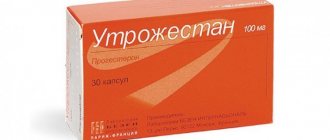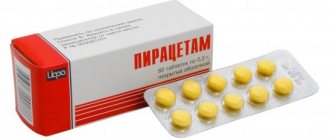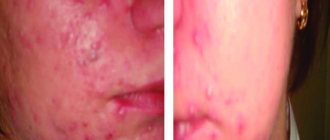Pharmacological properties of the drug Procarbazine
Alkylating cytostatic of the methylhydrazine class. Suppresses the process of mitotic cell division, probably acting on already formed DNA, as well as on DNA synthesis (purine methylation, DNA fragmentation). Since cross-resistance to other cytostatics is not observed, procarbazine is effective against tumors that are not amenable to treatment with other cytostatics. Procarbazine is quickly and completely absorbed from the digestive tract. The maximum concentration in blood plasma is achieved 30–60 minutes after oral administration. Penetrates into the CSF. It is believed that procarbazine or its toxic metabolites cross the placental barrier and into breast milk. Procarbazine is rapidly metabolized in the liver and kidneys. The effectiveness of procarbazine is attributed in part to hydrogen peroxide and hydroxyl radicals formed during its oxidation. About 70% of the dose is excreted in the urine within 24 hours.
Procarbazine
International name of the medicinal substance:
Procarbazine The list of drugs containing the active substance Procarbazine is given after the description.
Pharmacological action:
Antitumor agent, alkylating compound (from the group of methylhydrazines).
It disrupts the processes of transmethylation: the transfer of methyl radicals from methionine to transfer RNA (tRNA). The absence of a normally functioning t-RNA causes a disruption in the synthesis of DNA, RNA and proteins. An important component in the mechanism of action is the formation of hydrogen peroxide (the result of autooxygenation). Hydrogen peroxide, interacting with sulfhydryl groups of tissue proteins, promotes tighter spiralization of the DNA molecule and hinders transcription processes. Blocks the activity of MAO, which causes the accumulation of tyramine and an increase in the concentration of adrenaline in the endings of the sympathetic nervous system and an increase in blood pressure. Pharmacokinetics:
Quickly and completely absorbed from the gastrointestinal tract, penetrates the BBB. TCmax after oral administration - 30-60 minutes. Penetrates through the BBB. Metabolized in the liver to form active metabolites. T1/2 - 10 min. It is excreted by the kidneys - 70%, with less than 5% unchanged, and by the lungs - in the form of methane and carbon dioxide.
Indications:
Lymphogranulomatosis, malignant reticulosis, reticulosarcoma, Waldenström's disease, lymphosarcoma, Brill-Simmers disease, polycythemia vera, melanoma, myeloma, lung cancer, brain tumors, malignant thymoma, non-Hodgkin's lymphoma.
Contraindications:
Hypersensitivity, alcoholism, arrhythmias, CHF, ischemic heart disease, liver and/or renal failure, inhibition of bone marrow hematopoiesis (leukopenia, thrombocytopenia), thyrotoxicosis, diabetes mellitus, epilepsy, parkinsonism, acute infectious diseases of a viral, fungal or bacterial nature (including including chickenpox, herpes zoster), pregnancy, lactation.
Side effects:
From the nervous system: central nervous system stimulation, hypomanic and manic states;
weakness, increased fatigue; peripheral neuropathy, paresthesia, ataxia. From the digestive system: nausea, vomiting, diarrhea, abdominal pain; stomatitis, hepatotoxicity, cholestatic jaundice. From the hematopoietic organs and hemostasis system: leukopenia, thrombocytopenia, hemolytic anemia. From the cardiovascular system: hypertensive crisis, orthostatic hypotension. Other: alopecia, amenorrhea, azoospermia, immunosuppression, superinfection. Allergic reactions. Interaction:
Increases the activity of adrenergic stimulants, barbiturates, antidepressants and antipsychotic drugs (neuroleptics).
Incompatible with ethanol, may cause intolerance to the latter. Ethanol, anticoagulants, antiepileptic drugs, antidepressants, oral hypoglycemic drugs, beta-blockers, adrenergic stimulants, rauwolfia alkaloids enhance the effects of the drug. Special instructions:
During treatment you should refrain from drinking ethanol-containing drinks.
Treatment should be carried out under the control of the blood picture. When prescribing to patients who have previously been treated with cytostatics or a course of radiation therapy, caution must be exercised (the risk of toxic effects on the bone marrow is increased). Preparations containing the active substance Procarbazine:
Natulan
The information provided in this section is intended for medical and pharmaceutical professionals and should not be used for self-medication. The information is provided for informational purposes only and cannot be considered official.
Use of the drug Procarbazine
Therapy begins with low doses, which are gradually increased to a maximum daily dose of 250–300 mg. Start of treatment: 1st day - 50 mg, 2nd day - 100 mg, 3rd day - 150 mg, 4th day - 200 mg, 5th day - 250 mg, 6th and subsequent days - 250–300 mg. Treatment at a dose of 250–300 mg/day is continued until the most complete remission occurs, after which they switch to maintenance doses. If at the beginning of treatment the total number of leukocytes is less than 3000 per 1 mm3 or the number of platelets is less than 80,000 per 1 mm3, treatment should be temporarily suspended until the normal levels of leukocytes and platelets are restored, after which therapy is continued with maintenance doses. During maintenance therapy, the daily dose is 50–150 mg. Treatment should be continued until a total dose of 6 g is reached. For lymphogranulomatosis, the combination of procarbazine with other cytostatics, such as derivatives of nitrogen mustard and cyclophosphamide, vinca alkaloids and corticosteroids (MOPP/COPP regimen), has proven itself to be effective. With this combination therapy, good rates of both remission rates and five-year survival are achieved. When combining procarbazine with other cytostatics or radiation therapy, the above doses should be reduced.
Natulan Procarbazine (Natulan, P Carzine) capsules 50 mg No. 50 - Instructions
Compound
The main active ingredient is procarbazine.
Also included in the composition: starch, talc, magnesium stearate, mannitol, gelatin, titanium dioxide, E172.
Release form
The drug is produced in capsules, packaged in packages of 50 pieces.
pharmachologic effect
The exact therapeutic regimen of procarbazine has not yet been investigated. The drug slows down the binding of proteins, as well as the synthesis of DNA and RNA, destroying the processes of transmethylation - the movement of ash, which is transferred from methionine to the tRNA region. In the absence of a normally functioning tRNA, the binding of proteins and DNA to RNA is disrupted.
An important element in the processes of drug exposure is the formation of the substance H2O2, which occurs as a result of autoxidation. This ingredient interacts with the sulfhydryl categories of proteins that reside in tissues. This helps to narrow the helix of the DNA molecule, as well as complicate transcription processes.
Pharmacokinetics
The main element is completely and quickly absorbed in the gastrointestinal tract. When drugs are administered orally, the substance passes through the BBB, quickly reaching equilibrium between fluid and plasma levels. Peak values after oral administration are observed within 60 minutes.
Metabolism of the substance passes through the kidneys along with the liver; the process consists of 4 stages: oxidation, then isomerization and hydrolysis, then oxidation again, resulting in the formation of an exchange product - N-isopropyl terephthalic acid.
The half-life of the ingredient is approximately 10 minutes. About 70% of the substance is excreted in the urine within 24 hours.
Indications for use
It is used in the treatment of lymphogranulomatosis, lymphosarcoma, reticular sarcoma, as well as macrofolic lymphoblastoma.
Contraindications
Among the contraindications are:
- the presence of hypersensitivity to the drug and its components;
- mild to severe thrombocytopenia;
- severe liver or kidney problems.
Side effects
Nausea and loss of appetite were frequently reported early in the first days of therapy, but these symptoms always disappeared over time. The following negative reactions are also possible: constipation, hair loss, dry mouth, increased urination, chest pain, headache, nausea and vomiting, loss of appetite, skin rash.
Drug interactions
During therapy, you should avoid drinking alcohol (due to the possibility of disulfiram-like symptoms).
Procarbazine is a weak MAOI, so during its use it is necessary to exclude foods containing large amounts of tyramine (including cheese) from the diet, and you should not take certain medications with it. It is necessary to abandon the combination of antiepileptic drugs and sympathomimetics of this drug.
Application and dosage
The drug is taken orally after meals.
Therapy begins with a small dose, which is then gradually increased to a maximum of 0.25-0.3 g/day:
First day - consumption of 50 mg;
Day 2 - consumption 0.1 g;
3rd day - consumption of 0.15 mg;
4. Day - take 0.2 g;
5th day - use 0.25 g;
6th and subsequent days - consumption of 0.25-0.3 g.
Overdose
Symptoms of poisoning include diarrhea, dizziness, tachycardia, nausea, convulsions, tremors and vomiting, as well as hallucinations, increased blood pressure and depression.
To eliminate disturbances, vomiting or gastric lavage should be induced, followed by intravenous rehydration. Blood and liver function should be monitored for 14 days after the patient's condition has stabilized. In addition, antimicrobial prophylaxis is carried out.
special instructions
Treatment of 0.25-0.3 g/day should be continued until maximum remission of the disease is achieved. In addition, maintenance treatment of 50-150 mg of the drug per day is required.
Treatment should not be stopped until the usual dose of at least 6 g is reached, since it is difficult to assess remission results up to this limit. If the white blood cell count drops by 3,000 units and the platelet count reaches 80,000 during the initial phase of treatment, treatment should be temporarily stopped. Reception can be resumed when the parameters of the above points rise again.
Use during pregnancy and breastfeeding
The appointment is contraindicated.
Impact on the ability to drive vehicles and operate machinery
Caution must be exercised.
Terms of sale
As prescribed by a doctor.
Storage conditions
At room temperature, in a place out of reach of children.
Side effects of the drug Procarbazine
Like other cytostatics, procarbazine often causes side effects, although compared to other drugs in this group it is relatively well tolerated. The most pronounced side effects of procarbazine are anorexia, nausea, and sometimes vomiting (these symptoms are usually observed in the first days of treatment and then usually disappear), as well as leukopenia and thrombocytopenia. Changes in the blood system are almost always reversible and the need to completely stop treatment rarely occurs. Rarely, alopecia is observed, which is reversible in most cases. There are reports of neurological disorders (headache, paresthesia, neuropathy and ataxia), liver dysfunction (cholestatic jaundice), allergic skin reactions (rash, urticaria, itching), and in rare cases azoospermia occurs.
Drug interactions Procarbazine
Procarbazine is a weak MAO inhibitor and potentiates the effect of concomitantly used sympathomimetics, barbiturates, antidepressants and antipsychotics, so it is necessary to use reduced doses of these drugs. Patients taking procarbazine may develop intolerance to alcohol, so during treatment it is necessary to refrain from drinking it. In rare cases, eating cheese during treatment with MAO inhibitors can cause an increase in blood pressure, and although a similar effect is not known with the use of procarbazine, for safety reasons patients should be advised to refrain from eating cheese during treatment.




